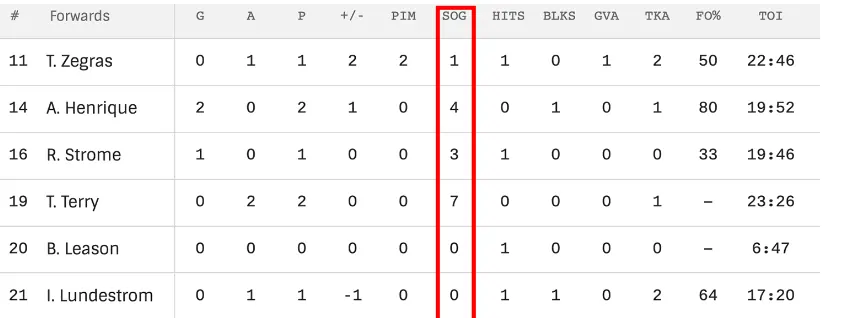Introduction to Shots on Goal in Hockey
SOG in hockey represent all attempts that would be goals if not blocked by the goalie or had they crossed the goal line successfully. This crucial statistic, often abbreviated as SOG, plays a vital role in assessing team and player performance during a game. Updated in real-time, SOG is prominently displayed on the venue scoreboard and meticulously documented in official game summaries.SOG is only considered valid if the puck is directed towards the net and has the potential to be a goal, barring the goalie’s intervention. Specifically, shots hitting the post or missing the net entirely do not qualify under this metric. Thus, both saved attempts by the goalie and successful goals are recorded as shots on goal.
Exploring Shots on Goal (SOG) and Related Metrics in Hockey
Shots on Goal (SOG) are recorded for each player in every game, indicating the number of attempts aimed at scoring. These statistics are essential as they contribute to both seasonal and career summaries of players.
For calculating a player’s effectiveness, the league evaluates the shooting percentage by correlating the total SOG with the number of goals scored. This ratio is pivotal in assessing a player’s precision and scoring efficiency.
Shots Against (SA) and Goaltender Metrics
For goaltenders, the Shots Against (SA) statistic represents the total number of SOG they encounter over a season. This data is crucial for evaluating a goalie’s workload and response under pressure.

Saves and Save Percentage (Sv%)
By subtracting the goals conceded from the total SOG, the number of saves made by a goaltender is derived. This figure is integral to calculating the Save Percentage (Sv%), which measures a goaltender’s effectiveness throughout the season or their career. The Save Percentage offers a clear insight into a goaltender’s ability to thwart scoring attempts, underlining their defensive prowess.
Key Definitions and Scenarios of SOG in Hockey
Shots on Goal (SOG) are fundamental in hockey, defined as shots that are either saved by the goalie or result in a goal. However, certain situations add complexity to this definition:
Non-Goal Scenarios
- Shot off the Post: A puck hitting the post without goalie contact is not counted as a SOG but as a missed shot.
- Goalie Interactions: If a goalie intercepts a shot going wide, it counts as a save, and the opposing team is credited with a SOG.
- Blocked Shots: Shots blocked by another player, whether intentionally or accidentally, do not count as SOG.

Special Shot Types
- Tip-In and Redirects: For tip-ins and redirects, the last player to touch the puck gets the SOG credit. If it results in a goal, the initial shooter receives an assist.
- Own Goals: If a defending player inadvertently redirects the puck into their net, the last opponent to touch the puck is credited with the shot.
Penalty and Shootout Specifics
- Penalty Shots: These are awarded during regulation or overtime. Successful shots count as SOG; misses or shots hitting the post do not.
- Shoot-Outs: While the mechanics mirror penalty shots, goals and shots in a shootout do not affect regular game statistics like shooting or save percentages. Only the outcome (win/loss) from the shootout affects the game’s final score, not the individual statistics.
Understanding Shot Attempts
- Overall Attempts: Every shot directed towards the goal, whether blocked, missed, or saved, contributes to total shot attempts, which include all SOG, misses, and blocks.
Understanding Own Goals and Empty Net Situations in Hockey
Own Goals Dynamics
When a player inadvertently scores in their own net, the goal and the Shot on Goal (SOG) are credited to the last opponent who touched the puck. This rule ensures that the scoring team is acknowledged for their pressure and influence that led to the goal, even if they didn’t directly shoot the puck into the net.

Scoring on an Empty Net
- Empty Net Opportunities: When a team removes their goalie to add an extra attacker, the opposing team has a chance to score into the unguarded net. This strategy is used in critical game situations to increase offensive power.
- Rules Against Unfair Defense: To maintain fairness, the defending team is prohibited from using illegal methods to prevent a likely goal against an empty net. Actions such as throwing sticks, tripping players, or displacing the net are strictly forbidden.
- Automatic Goals: If the defending team commits an infraction to prevent a goal during an empty net scenario, the referee can award an automatic goal to the attacking team, even if an actual shot was not taken.
Conclusion
Shots on Goal (SOG) is a pivotal statistic in hockey, indicating how many shots a team or player directs towards the opponent’s net. This metric sheds light on offensive dynamics, precision in shooting, and potential scoring chances. While SOG is instrumental in evaluating offensive output, it’s one of several factors that contribute to understanding a player’s full offensive impact.
Read also: What Exactly is PIM in Hockey? Unpacking the Penalty Details
FAQ’s: SOG in Hockey
How is the Shots on Goal (SOG) metric tracked in hockey?
In hockey, Shots on Goal (SOG) are noted whenever a player takes a shot that would have entered the goal if it hadn’t been stopped, blocked, or redirected by an opponent or the goalie.
What qualifies as a SOG in hockey?
In hockey, a shot on goal (SOG) is recorded when a player aims a puck towards the net intending to score, and it would have entered the net if not for the goaltender’s intervention.
Why is the Shots on Goal (SOG) statistic significant in hockey?
In hockey, Shots on Goal (SOG) is a crucial metric as it reveals the effectiveness of a team’s offense. It indicates the number of scoring chances a team generates and provides insights into their shooting precision and efficacy.
How do teams and coaches utilize the Shots on Goal (SOG) statistic?
Teams and coaches use the Shots on Goal (SOG) statistic to assess their offensive strategies, pinpoint scoring patterns, and refine tactics during games or practice sessions. This metric also serves to compare the performance and effectiveness of different teams or players.
Does a shot that strikes the post or crossbar count as a Shot on Goal?
No, a shot that hits the post or crossbar does not qualify as a Shot on Goal (SOG). For a shot to be recorded as SOG, it must be on target and would have entered the net if not intercepted or deflected by an opponent or the goaltender.
Is Shots on Goal the sole determinant of a player’s offensive contribution in hockey?
No, Shots on Goal (SOG) is an important metric but not the only indicator of a player’s offensive impact. Additional factors like assists, goals, shooting percentage, and overall playmaking skills are essential for a comprehensive assessment of a player’s offensive contributions.
Do Shots on Goal equate to scoring chances in hockey?
While Shots on Goal (SOG) may indicate scoring opportunities, not all shots on goal directly correlate with true scoring chances. Scoring chances are typically high-quality attempts with a greater likelihood of leading to a goal.



